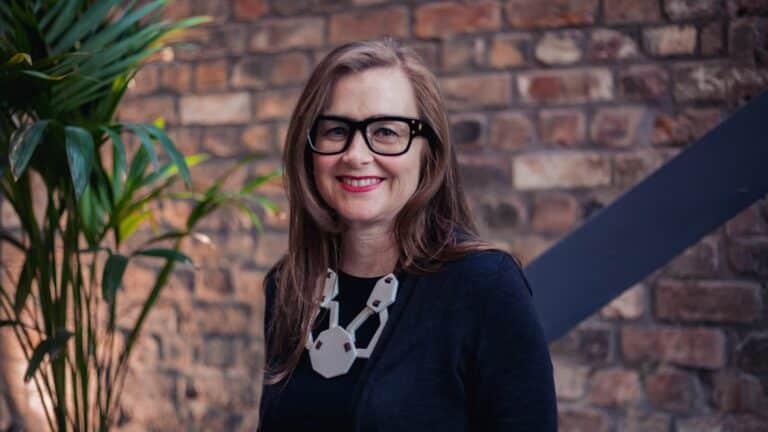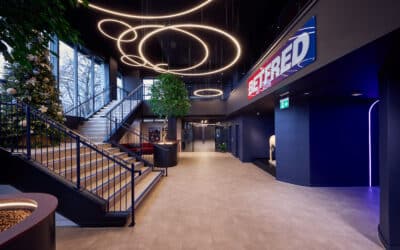There is now a thriving creative and digital community of over 100 businesses based at Liverpool’s Baltic Triangle, a former derelict district of the city. It shows the importance of regeneration and ‘placemaking’, writes Lynn Haime, CEO at Baltic Creative, and what’s happening in Liverpool could – and should – be replicated across the North.
The creative and digital sector is one of the fastest growing in the UK, with nearly 300,000 businesses currently operating within the space. The sector has ambitions to grow by £50bn, as well as to create over a million more jobs by 2030. Much of this activity is currently happening in the North of England, which has become a thriving hive of activity for this growing industry.
Within the Liverpool City Region alone, the sector’s GVA has increased by 34%, with this figure rising to 117% when we look at Liverpool specifically.
According to a 2023 report from commercial real estate firm Avison Young, the North West’s creative and digital sector is expected to grow by over 10% by 2028 – a clear testament to the fertile ground we’ve cultivated regionally and the infrastructure we’ve invested in.
For me, place is intrinsically connected to the growth we’ve achieved and the growth we see on the horizon. The continued evolution of the creative and digital sector is the result of very deliberate and strategic efforts around regeneration, achieved through building a robust ecosystem that supports founders, fosters community, and drives economic growth.
In many ways, the Baltic Triangle in Liverpool is the template for this kind of work, and its regeneration now sits as an exemplar project, regionally and nationally, highlighting what can be achieved when creative focus and forward-thinking investment align.
This is an exciting moment for the North to shine – taking the Baltic Creative blueprint and using regeneration and placemaking as tools to build thriving creative and digital ecosystems to unlock sector growth.
The Baltic Creative blueprint
Fifteen years ago, the Baltic Triangle was a largely forgotten district of Liverpool, characterised by its derelict warehouses and industrial spaces. What we see today is almost unrecognisable by comparison, with the area having slowly but surely developed into the beating heart of the city’s creative and digital community – thanks, in large part, to our collective vision and determination, along with public sector support.
The Baltic Creative scheme has not only provided much-needed floorspace for businesses to scale and succeed within, but has fostered a thriving ecosystem, enabling businesses to collaborate and innovate. From the very beginning, our approach has been holistic, focusing not simply on renovating buildings but on creating an environment that sets the community, and the sector, up for success.
The triumph of the Baltic Triangle makes it an undeniable blueprint for creative and digital placemaking – demonstrating how targeted regeneration can spark growth in the sector and across regions. As a result of the area’s success and huge desirability, the Baltic Triangle placed 11th in Time Out’s 40 Coolest Neighbourhoods in the World list in 2023 – outranking even the likes of the Arts District in Downtown Los Angeles.
Levelling up through regeneration
The Levelling Up agenda is a crucial lens through which to understand the importance and impact of this kind of work. By investing in underutilised urban areas, developers can unlock potential, not just for the creative and digital sector, but for the wider community. Liverpool’s experience shows how such regeneration can light the fuse of economic dynamism.
In November of last year, while speaking on a panel at Avison Young’s Urban Futures event in Liverpool, I emphasised the immense opportunity that the creative and digital sector presents to our regional economy, and the critical role of placemaking and regeneration in driving that growth.
With the backdrop of a volatile market and rising rents that continue to displace many creative and digital businesses, dedicated and affordable spaces that enable growth and build communities are imperative. We need focused efforts to fuel regeneration across the North, replicating the Baltic Creative approach to ensure that our regions remain competitive, vibrant and, ultimately, desirable for occupiers and inward investment.
More than bricks and mortar
Creative and digital placemaking is about more than just the physical redevelopment of spaces. It’s about creating ecosystems that support businesses, leverage the right kinds of investment, enable access to opportunity, and drive sector growth.
Now, with a model for success, local authorities across the North should be thinking about how they can connect the dots between regeneration and sector growth, investing in ambitious placemaking initiatives to drive prosperity for businesses, retain talent, and to close the gap between the North and London and the South East.
As we look to the future, the imperative for action is clear. Many of our towns and cities are in urgent need of regeneration and, by investing in the creation of creative and digital communities to house the North’s ambitious, forward-thinking start-ups and scale-ups, we can ensure that our businesses and our regions contribute to a dynamic, diverse and resilient economy.











